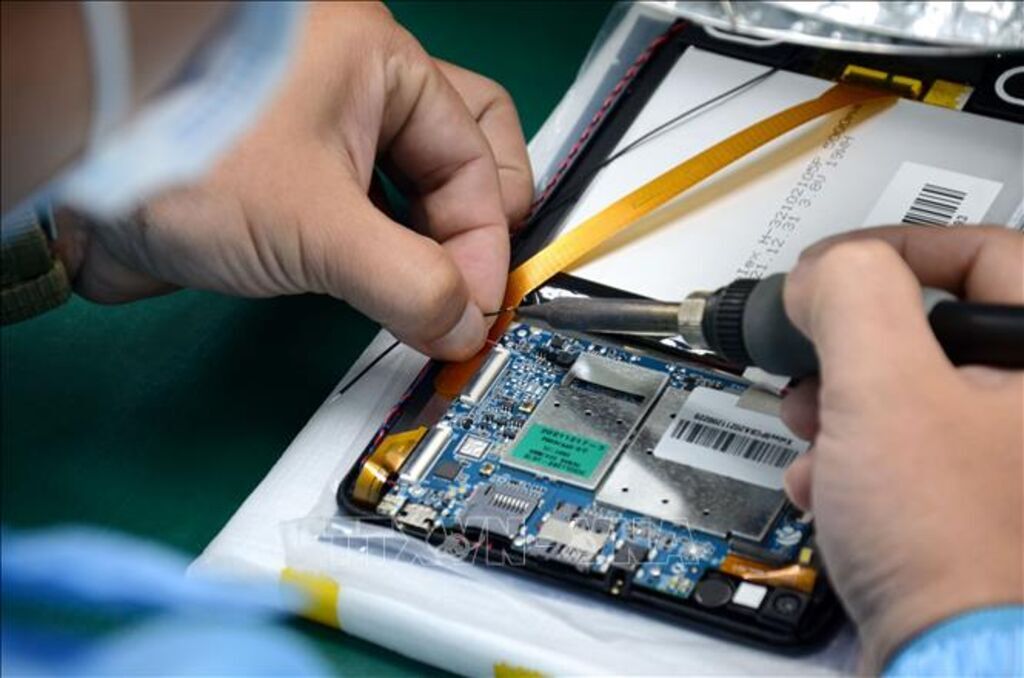 |
| Manufacturing tablets at the Trung Nam EMS factory in Da Nang city’s concentrated IT Park.__Photo: Quoc Dung/VNA |
* By 2030, Vietnam targets to have at least 50,000 high-skilled workers with university or higher degree to serve the semiconductor industry, with 42,000 engineers and graduates, 7,500 workers possessing master’s degree and 500 doctoral candidates.
Such is one of the targets set forth in Prime Minister Decision 1017/QD-TTg dated September 21, approving the Program on development of human resources for the semiconductor industry through 2030, with orientations toward 2050.
As stated in the Program, the country will focus on training and developing a high-quality workforce for the semiconductor industry, focusing on designing, packaging, and testing of semiconductor chips, gradually mastering the technology in the semiconductor production process.
In light of this, by 2030, at least 15,000 persons will be trained in the designing stage while 35,000 persons will be trained in production, packaging, testing, and other stages.
Meanwhile, it is expected to provide training for at least 5,000 laborers with in-depth expertise in artificial intelligence to serve the semiconductor industry.
Besides, in-depth training will also be provided to 1,300 Vietnamese lecturers teaching at research institutes, higher education institutions, training support facilities, and enterprises.
By 2050, Vietnam hopes to have a strong workforce and join the global semiconductor industry value chain, while its training institutions will be capable of training high-quality human resources serving the development of Vietnam's semiconductor industry.
* Also on September 21, under Decision 1018/QD-TTg, the Prime Minister approved the Strategy for development of Vietnam’s semiconductor industry through 2030, with a vision toward 2050. Accordingly, the semiconductor industry will be developed in three phases.
In the first phase from 2024 to 2030, it is expected to make use of geopolitical and workforce advantages and selectively attract foreign direct investment (FDI) to turn the country into one of the global semiconductor manpower centers and build capacity in all stages, from research, designing, and manufacturing to packaging and testing for the semiconductor industry.
In this phase, the semiconductor industry aims at the annual revenue exceeding USD 25 billion with an added value growth rate of 10-15 percent. Meanwhile, the electronics industry will surpass USD 225 billion in annual revenue and 10-15 percent in added value growth.
In the second phase, the 2030-40 period, the country is set to become one of global semiconductor and electronics centers, while developing the semiconductor and electronics industries with its own resources together with FDI. Specifically, there will be at least 200 design companies and 15 packaging and testing plants of semiconductor products, and two manufacturing factories of semiconductor chips, gradually mastering design and production technologies for special-use semiconductor products.
During 2040-50, the third phrase, Vietnam looks to become one of the world’s leading countries in the semiconductor and electronics industries and master research and development in these fields.
For specific targets, the annual revenues of the semiconductor industry and electronics industry are expected to surpass USD 100 billion and USD 1,045 billion, respectively, with the same growth rate of 20-25 percent in added value.
To realize the above-said goals, the Strategy sets out several tasks with certain solutions, such as developing special-use semiconductor chips and electronic industry; strengthening human resources and attracting talents for the semiconductor industry; and calling for more investment in the semiconductor industry, among others.-









